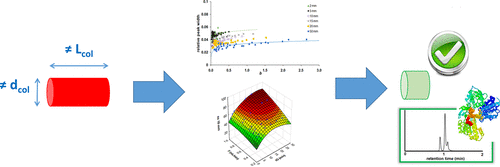当前位置:
X-MOL 学术
›
Anal. Chem.
›
论文详情
Our official English website, www.x-mol.net, welcomes your feedback! (Note: you will need to create a separate account there.)
Use of Ultra-short Columns for Therapeutic Protein Separations, Part 2: Designing the Optimal Column Dimension for Reversed-Phase Liquid Chromatography
Analytical Chemistry ( IF 7.4 ) Pub Date : 2020-12-11 , DOI: 10.1021/acs.analchem.0c01720 Szabolcs Fekete 1 , Amarande Murisier 1 , Jennifer M. Nguyen 2 , Michael J. Bolton 3 , Jonathan Belanger 2 , Alain Beck 4 , Jean-Luc Veuthey 1 , Kevin Wyndham 2 , Matthew A. Lauber 2 , Davy Guillarme 1
Analytical Chemistry ( IF 7.4 ) Pub Date : 2020-12-11 , DOI: 10.1021/acs.analchem.0c01720 Szabolcs Fekete 1 , Amarande Murisier 1 , Jennifer M. Nguyen 2 , Michael J. Bolton 3 , Jonathan Belanger 2 , Alain Beck 4 , Jean-Luc Veuthey 1 , Kevin Wyndham 2 , Matthew A. Lauber 2 , Davy Guillarme 1
Affiliation

|
In the first part of the series, it was demonstrated that very fast (<30 s) separations of therapeutic protein species are feasible using ultra-short (5 × 2.1 mm) columns. In the second part, our purpose was to find the appropriate column length; therefore, a systematic study was performed using various custom-made prototype reversed-phase liquid chromatography (RPLC) columns ranging from 2 to 50 mm lengths. It was found that on a low dispersion ultrahigh-pressure liquid chromatography instrument, columns between 10 and 20 mm were most effective when made with 2.1 mm i.d. tubing. However, with the same LC instrument, 3 mm i.d. columns as short as ∼5 to 10 mm could be effectively used. In both cases, it has been found to be best to keep injection volumes below 0.6 μL, which presents a potential limit to further decreasing column length, given the current capabilities of autosampler instrumentation. The additional volume of the column hardware outside of the packed bed (extra-bed volume) of very small columns is also a limiting factor to decrease the column length. For columns shorter than 10 mm, columns’ extra-bed volume was seen to make considerable contributions to band broadening. However, the use of ultra-short columns seemed to be a very useful approach for RPLC of large proteins (>25 kDa) and could also work well for ∼12 kDa as the lowest limit of molecular mass. In summary, a renewed interest in the use of ultra-short columns is warranted, and additional method development will be to the benefit of the biopharmaceutical industry as there is an ever-increasing demand for faster, yet accurate assays (e.g., high-throughput screening) of proteins.
中文翻译:

超短柱在治疗性蛋白质分离中的应用,第2部分:设计反相液相色谱的最佳柱尺寸
在该系列的第一部分中,已证明使用超短(5×2.1 mm)色谱柱可以非常快速地(<30 s)分离治疗性蛋白质。在第二部分中,我们的目的是找到合适的列长。因此,使用各种定制的原型原型反相液相色谱(RPLC)色谱柱进行了系统研究,色谱柱的长度范围为2至50 mm。结果发现,在低分散超高压液相色谱仪上,使用内径为2.1 mm的管制成的10至20 mm的色谱柱最有效。但是,使用相同的LC仪器,可以有效地使用短至约5至10 mm的3 mm内径色谱柱。在这两种情况下,最好将进样量保持在0.6μL以下,这对于进一步缩短色谱柱长度提出了潜在的限制,鉴于自动进样器仪器的当前功能。很小的色谱柱在填充床外部的色谱柱硬件的额外体积(床外体积)也是减小色谱柱长度的限制因素。对于短于10 mm的色谱柱,可以看到色谱柱的床外体积对谱带展宽做出了巨大贡献。但是,对于大蛋白(> 25 kDa)的RPLC,使用超短色谱柱似乎是非常有用的方法,并且作为最低分子量上限,在〜12 kDa的情况下也可以很好地工作。总之,对超短柱的使用产生了新的兴趣,并且随着对快速,准确测定的不断增长的需求,更多的方法开发将使生物制药行业受益(很小的色谱柱在填充床外部的色谱柱硬件的额外体积(床外体积)也是减小色谱柱长度的限制因素。对于短于10 mm的色谱柱,可以看到色谱柱的床外体积对谱带展宽做出了巨大贡献。但是,对于大蛋白(> 25 kDa)的RPLC,使用超短色谱柱似乎是非常有用的方法,并且作为最低分子量上限,在〜12 kDa的情况下也可以很好地工作。总之,对超短柱的使用产生了新的兴趣,并且随着对快速,准确测定的不断增长的需求,更多的方法开发将使生物制药行业受益(很小的色谱柱在填充床外部的色谱柱硬件的额外体积(床外体积)也是减小色谱柱长度的限制因素。对于短于10 mm的色谱柱,可以看到色谱柱的床外体积对谱带展宽做出了巨大贡献。但是,对于大蛋白(> 25 kDa)的RPLC,使用超短色谱柱似乎是非常有用的方法,并且作为最低分子量上限,在〜12 kDa的情况下也可以很好地工作。总之,对超短柱的使用产生了新的兴趣,并且随着对快速,准确测定的不断增长的需求,更多的方法开发将使生物制药行业受益(人们认为色谱柱的床外体积对谱带拓宽做出了巨大贡献。但是,对于大蛋白(> 25 kDa)的RPLC,使用超短色谱柱似乎是非常有用的方法,并且作为最低分子量上限,在〜12 kDa的情况下也可以很好地工作。总之,对超短柱的使用产生了新的兴趣,并且随着对快速,准确测定的不断增长的需求,更多的方法开发将使生物制药行业受益(人们认为色谱柱的床外体积对谱带拓宽做出了巨大贡献。但是,对于大蛋白(> 25 kDa)的RPLC,使用超短色谱柱似乎是非常有用的方法,并且作为最低分子量上限,在〜12 kDa的情况下也可以很好地工作。总之,对超短柱的使用产生了新的兴趣,并且随着对快速,准确测定的不断增长的需求,更多的方法开发将使生物制药行业受益((例如,高通量筛选)蛋白质。
更新日期:2021-01-26
中文翻译:

超短柱在治疗性蛋白质分离中的应用,第2部分:设计反相液相色谱的最佳柱尺寸
在该系列的第一部分中,已证明使用超短(5×2.1 mm)色谱柱可以非常快速地(<30 s)分离治疗性蛋白质。在第二部分中,我们的目的是找到合适的列长。因此,使用各种定制的原型原型反相液相色谱(RPLC)色谱柱进行了系统研究,色谱柱的长度范围为2至50 mm。结果发现,在低分散超高压液相色谱仪上,使用内径为2.1 mm的管制成的10至20 mm的色谱柱最有效。但是,使用相同的LC仪器,可以有效地使用短至约5至10 mm的3 mm内径色谱柱。在这两种情况下,最好将进样量保持在0.6μL以下,这对于进一步缩短色谱柱长度提出了潜在的限制,鉴于自动进样器仪器的当前功能。很小的色谱柱在填充床外部的色谱柱硬件的额外体积(床外体积)也是减小色谱柱长度的限制因素。对于短于10 mm的色谱柱,可以看到色谱柱的床外体积对谱带展宽做出了巨大贡献。但是,对于大蛋白(> 25 kDa)的RPLC,使用超短色谱柱似乎是非常有用的方法,并且作为最低分子量上限,在〜12 kDa的情况下也可以很好地工作。总之,对超短柱的使用产生了新的兴趣,并且随着对快速,准确测定的不断增长的需求,更多的方法开发将使生物制药行业受益(很小的色谱柱在填充床外部的色谱柱硬件的额外体积(床外体积)也是减小色谱柱长度的限制因素。对于短于10 mm的色谱柱,可以看到色谱柱的床外体积对谱带展宽做出了巨大贡献。但是,对于大蛋白(> 25 kDa)的RPLC,使用超短色谱柱似乎是非常有用的方法,并且作为最低分子量上限,在〜12 kDa的情况下也可以很好地工作。总之,对超短柱的使用产生了新的兴趣,并且随着对快速,准确测定的不断增长的需求,更多的方法开发将使生物制药行业受益(很小的色谱柱在填充床外部的色谱柱硬件的额外体积(床外体积)也是减小色谱柱长度的限制因素。对于短于10 mm的色谱柱,可以看到色谱柱的床外体积对谱带展宽做出了巨大贡献。但是,对于大蛋白(> 25 kDa)的RPLC,使用超短色谱柱似乎是非常有用的方法,并且作为最低分子量上限,在〜12 kDa的情况下也可以很好地工作。总之,对超短柱的使用产生了新的兴趣,并且随着对快速,准确测定的不断增长的需求,更多的方法开发将使生物制药行业受益(人们认为色谱柱的床外体积对谱带拓宽做出了巨大贡献。但是,对于大蛋白(> 25 kDa)的RPLC,使用超短色谱柱似乎是非常有用的方法,并且作为最低分子量上限,在〜12 kDa的情况下也可以很好地工作。总之,对超短柱的使用产生了新的兴趣,并且随着对快速,准确测定的不断增长的需求,更多的方法开发将使生物制药行业受益(人们认为色谱柱的床外体积对谱带拓宽做出了巨大贡献。但是,对于大蛋白(> 25 kDa)的RPLC,使用超短色谱柱似乎是非常有用的方法,并且作为最低分子量上限,在〜12 kDa的情况下也可以很好地工作。总之,对超短柱的使用产生了新的兴趣,并且随着对快速,准确测定的不断增长的需求,更多的方法开发将使生物制药行业受益((例如,高通量筛选)蛋白质。


























 京公网安备 11010802027423号
京公网安备 11010802027423号